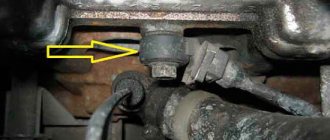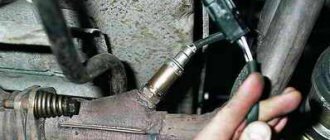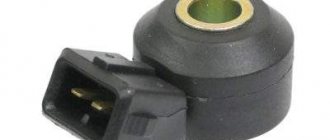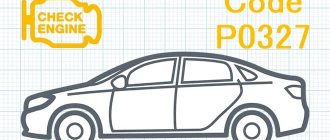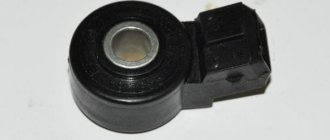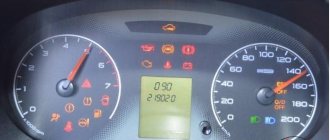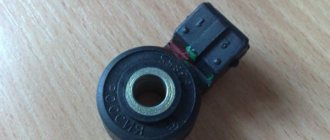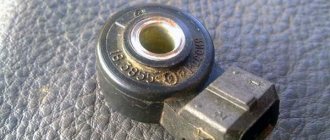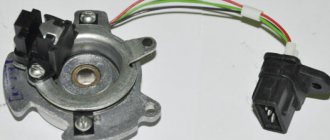A knock detection sensor (DS) in the engine cylinders was not an obvious need in the first engine control systems, and in the days of simpler principles of power management and ignition of gasoline internal combustion engines, abnormal combustion of the mixture was not monitored at all. But then the engines became more complex, the requirements for efficiency and exhaust purity increased sharply, which required an increase in the amount of control over their operation at each time.
Lean and ultra-lean mixtures, exorbitant compression ratios and other similar factors require constant work on the verge of detonation without going beyond this threshold.
What is detonation and its consequences?
Detonation is when part of the air-fuel mixture, distant from the spark plug electrodes, ignites on its own. Because of this, the flame spreads unevenly throughout the chamber and a sharp push occurs on the piston. Often this process can be recognized by a ringing metallic knock. In this case, many motorists say that their fingers are knocking.
Under normal conditions, the mixture of air and fuel compressed in the cylinder begins to ignite evenly when a spark is formed. Combustion in this case occurs at a speed of 30 m/sec. The detonation effect is uncontrollable and chaotic. At the same time, the military-technical vehicle burns out much faster. This value in some cases can reach up to 2 thousand m/s.
1) Spark plug; 2) Combustion chamber; A) Normal fuel combustion; B) Detonation combustion of gasoline.
Such excessive load negatively affects the condition of most parts of the crank mechanism (read about the structure of this mechanism separately ), valves, hydraulic compensator of each of them, etc. An engine overhaul on some models can cost as much as half an identical used car.
Detonation can damage the power unit after 6 thousand kilometers, and in some cars even earlier. This malfunction will depend on:
- Fuel quality. Most often, this effect occurs in gasoline engines when using inappropriate gasoline. If the octane number of the fuel does not meet the requirements (usually uninformed motorists buy cheaper fuel, which has a lower octane rating) specified by the engine manufacturer, then the likelihood of detonation is high. The octane number of fuel is described in detail in another review . But in short, the higher this value, the lower the probability of the formation of the effect in question.
- Power unit designs. To increase the efficiency of the internal combustion engine, engineers make adjustments to the geometry of various engine elements. During the modernization process, the compression ratio may change (it is described here ), the geometry of the combustion chamber, the location of the spark plugs, the geometry of the piston crown and other parameters.
- The condition of the engine (for example, carbon deposits on the actuators of the cylinder-piston group, worn o-rings or increased compression after a recent modernization) and its operating conditions.
- Conditions of spark plugs (read about how to determine their malfunction here ).
How to deal with this?
One of the simplest methods of getting rid of detonation is to change the ignition angle. After all, this parameter significantly affects the operation of the power unit. With late ignition, the fuel does not have time to burn completely, which affects power, throttle response, and fuel consumption. And with an early ignition angle, detonation combustion occurs - the fuel burns ahead of time, which leads to the appearance of shock loads on the piston group and the crank mechanism.
In carburetor cars, detonation was eliminated by turning the distributor, ensuring later ignition.
In modern injection cars, it is impossible to manually change the advance angle, since this parameter is adjusted by the electronic engine control system. Essentially, the car itself regulates the ignition to provide maximum power output with the lowest possible fuel consumption. Moreover, this is achieved at a slightly early ignition, when the angle is set so that detonation combustion does not occur. But as already mentioned, the occurrence of this effect depends on many factors.
Video: Knock sensors
Why do you need a knock sensor?
As you can see, the influence of the detonation effect in the engine is too great and dangerous for the condition of the engine to be ignored. To determine whether a microexplosion occurs in a cylinder or not, a modern engine will have a corresponding sensor that reacts to such bursts and disturbances in the operation of the internal combustion engine (this is a shaped microphone that converts physical vibrations into electrical impulses). Since the electronics provide finer tuning of the power unit, only the injection engine is equipped with a knock sensor.
When detonation occurs in the engine, a load surge occurs not only on the crankshaft, but on the cylinder walls and valves. To ensure that these parts do not fail, it is necessary to adjust the optimal combustion of the fuel-air mixture. To achieve this, it is important to fulfill at least two conditions: select the correct fuel and set the ignition timing correctly. If these two conditions are met, then the power of the power unit and its efficiency will reach the maximum parameter.
The problem is that in different operating modes of the motor it is necessary to slightly change its settings. This becomes possible thanks to the presence of electronic sensors, including detonation sensors. Let's look at its device.
Voltage measurement at idle
The performance of the motor can be determined by measuring the voltage at its contacts with the engine running at idle speed. The table below shows approximate voltage values that can be used to identify a malfunction of the knock sensor.
Table - Approximate voltage values
| Voltage, V | Sensor status |
| 0-0.01 | Unusable, voltage too low |
| 0.2-4.5 | Knock meter is OK |
| Over 5 | Sensor broken, voltage too high |
Knock sensor device
On the modern automotive parts market there is a wide variety of sensors for detecting engine detonation. A classic sensor consists of:
- A housing that is fixed to the outside of the cylinder block using a bolted connection. In the classic version, the sensor looks like a small silent block (rubber bushing with a metal clip). Some types of sensors are made in the form of a bolt, inside which all the sensitive elements of the device are located.
- Contact washers located inside the housing.
- Piezoelectric sensing element.
- Electrical connector.
- Inertial substance.
- Disc spring.
1. Contact washers;
2. Inertial mass; 3. Body; 4. Belleville spring; 5. Fastening bolt; 6. Piezoceramic sensitive element; 7. Electrical connector; 8. Cylinder block; 9. Cooling jacket with antifreeze. The sensor itself in an inline 4-cylinder engine is usually installed between the 2nd and 3rd cylinders. In this case, checking the engine operating mode is more effective. Thanks to this, the operation of the unit is leveled not due to malfunctions in one boiler, but as much as possible in all cylinders. In engines with a different design, for example, a V-shaped version, the device will be located in a place where detonation is more likely to occur.
Device and method for checking DD
How the engine knock sensor works has not yet been considered. That is, you need to understand what the principle of its operation is based on. And it is based, as many people know, on the phenomenon of the piezoelectric effect.
Let's say two wires are connected to the edges of a piezoelectric crystal, and the crystal itself experiences deformation. Then electrical voltage appears on the wires. Its value increases with increasing amplitude of influences, which makes it possible to use a piezoelectric sensor as an acceleration meter.
Conclusion: The knock sensor measures acceleration and nothing else.
How to check if the DD sensor is working
Actually, they check the sensor like this: connect the leads to a multimeter, tap the body with a screwdriver. The instrument scale should display at least some numbers (not “0”).
And now - seriously:
- In professional workshops, the sensor is connected not to a voltmeter, but to an oscilloscope;
- When using a multimeter, use the maximum sensitivity threshold;
- It makes sense to measure the resistance of the sensor - it cannot be less than 100 kOhm.
Before performing any installation work, disconnect the negative terminal of the battery. You can connect it when the installation is complete.
How does a knock sensor work?
The operation of the knock sensor is reduced to ensuring that the control unit can adjust the OZ, ensuring controlled combustion of the vehicle. When detonation occurs in the engine, it produces strong vibration. The sensor detects load spikes due to uncontrolled ignition and converts them into electronic pulses. These signals are then sent to the ECU.
Depending on the information received from other sensors, different algorithms are activated in the microprocessor. Electronics changes the operating mode of the actuators that are part of the fuel and exhaust systems, the car ignition, and in some engines it drives the phase shifter (a description of the operation of the variable valve timing mechanism is here ). Thanks to this, the combustion mode of the VTS changes, and the operation of the motor adapts to the changed conditions.
So, the sensor installed on the cylinder block works according to the following principle. When uncontrolled combustion of the HTC occurs in the cylinder, the piezoelectric sensing element reacts to vibrations and generates voltage. The stronger the oscillation frequency in the motor, the higher this indicator.
The sensor is connected to the control unit using wires. The ECU is set to a certain voltage value. When the signal exceeds the programmed value, the microprocessor sends a signal to the ignition system to change the OZ. In this case, the correction is made in the direction of decreasing the angle.
As you can see, the function of the sensor is to convert vibrations into an electrical impulse. In addition to the fact that the control unit activates algorithms for changing the ignition timing, the electronics also adjusts the composition of the mixture of gasoline and air. As soon as the oscillation threshold exceeds the permissible value, a corrective electronics algorithm will be triggered.
In addition to protecting against load surges, the sensor helps the control unit adjust the power unit for the most efficient combustion of the vehicle. This parameter will affect engine power, fuel consumption, the condition of the exhaust system, and especially the catalyst (why it is needed in the car is discussed separately ).
What determines the occurrence of detonation?
So, detonation can appear both as a result of incorrect actions of the car owner, and for natural reasons beyond the control of the person. In the first case, the driver may mistakenly pour inappropriate gasoline into the tank (read about what to do in this case here ), poorly monitor the condition of the engine (for example, consciously increase the scheduled engine maintenance interval).
The second reason for uncontrolled fuel combustion is the natural process of engine operation. When it reaches higher speeds, the ignition starts to fire later than the piston reaches its most efficient position in the cylinder. For this reason, at different operating modes of the unit, either earlier or later ignition is required.
Do not confuse cylinder detonation with natural engine vibrations. Despite the presence of balancing elements in the crankshaft , the internal combustion engine still creates certain vibrations. For this reason, so that the sensor does not detect these vibrations as detonation, it is configured to operate when a certain range of resonance or vibrations is reached. In many cases, the noise range at which the sensor will begin to produce a signal is between 30 and 75 Hz.
So, if the driver is attentive to the condition of the power unit (serves it in a timely manner), does not overload it and fills it with the appropriate gasoline, this does not mean that detonation will never occur. For this reason, you should not ignore the corresponding signal on the dashboard.
How to check functionality?
If error code 34 appears on the display, this indicates a sensor malfunction. It is possible to check whether it is still operational or whether it needs immediate replacement. Having completely reset the self-diagnosis results, you need to drive a couple of kilometers and turn on the self-diagnosis system again.
If a new check shows an error again, then replacement is still necessary. If the error is not displayed, then you can still operate the old device. But since code 34 was still displayed earlier, it’s worth checking the connection for a break, that is, carefully inspect the wires, contacts, tighten them, clean them, and you’ll see that replacement won’t be needed.
Errors on the instrument panel display
Considering that the VAZ 2110 can drive for some time without a knock sensor, you can carry out a more thorough check of it, but for this you will have to remove the device.
Types of sensors
All modifications of knock sensors are divided into two types:
- Broadband. This is the most common modification of devices. They will work according to the principle stated earlier. They are usually made in the form of a rubber round element with a hole in the center. Through this part, the sensor is screwed to the cylinder block using a bolt.
- Resonant. This modification is similar in design to an oil pressure sensor. They are often made in the form of a fitting with threads and edges for installation with a wrench. Unlike the previous modification, which records vibrations, resonant sensors detect the frequency of micro-explosions. These devices are manufactured for specific types of motors, since the frequency of micro-explosions and their strength depend on the size of the cylinders and pistons.
Signs and causes of a malfunctioning knock sensor
A faulty DD can be identified by the following signs:
- In normal operation, the engine should run as smoothly as possible, without shaking. Typically, detonation is detected by a characteristic metallic sound while the engine is running. However, this symptom is indirect, and a professional can determine a similar problem by sound. Therefore, if the engine begins to shake or it runs jerkily, then it is worth checking the knock sensor.
- The next indirect sign of a faulty sensor is a decrease in power characteristics - poor response to the gas pedal, unnatural crankshaft speed (for example, very high at idle). This can happen because the sensor transmits incorrect data to the control unit, so the ECU unnecessarily changes the ignition timing, destabilizing engine operation. Such a malfunction will not allow it to accelerate correctly.
- In some cases, due to a breakdown of the DD, the electronics cannot adequately set the OZ. If the engine has cooled down, for example, during overnight parking, then cold starting will be difficult. This can occur not only in winter, but also in the warm season.
- There is an increase in gasoline consumption, while all car systems are working properly, and the driver continues to use the same driving style (even with working equipment, an aggressive style will always be accompanied by an increase in fuel consumption).
- The Check Engine light came on on the dashboard. In this case, the electronics detects the absence of a signal from the DD and generates an error. This also happens when the sensor readings are unnatural.
It is worth considering that none of the listed symptoms is a 100% guarantee of sensor failure. They may be evidence of other vehicle problems. They can only be accurately recognized during diagnosis. On some vehicles, you can activate the self-diagnosis process. You can read about how to do this here .
If we talk about the causes of sensor malfunctions, we can highlight the following:
- The physical contact of the sensor housing with the cylinder block is broken. Experience shows that this reason is the most common. This usually occurs due to a violation of the tightening torque of the stud or fixing bolt. Since the motor still vibrates during operation, and due to careless operation, the seat may become contaminated with lubricant, these factors lead to the device being loosened. When the tightening torque decreases, the sensor receives shocks from micro-explosions worse, and over time it stops responding to them and generating electrical impulses, detecting detonation as a natural vibration. To eliminate such a malfunction, you need to unscrew the fastener, remove oil contamination (if any) and sufficiently tighten the fastener. At some unscrupulous service stations, instead of telling the truth about such a problem, the technicians inform the car owner that the sensor has failed. An inattentive client can spend money on a new sensor that doesn’t exist, and the technicians will simply tighten the mount.
- Violation of wiring integrity. This category includes a large number of different faults. For example, due to improper or poor fixation of an electrical line, wire strands may break over time or the insulating layer on them may wear through. This may result in a short circuit or open circuit. Wiring damage can often be detected by visual inspection. If necessary, you just need to replace the chip with wires or connect the DD and ECU contacts using other wires.
- Sensor failure. This element itself has a simple structure, in which there is little to break. But if it breaks down, which happens extremely rarely, it is replaced, since it cannot be repaired.
- Errors in the control unit. Essentially, this is not a breakdown of the sensor, but sometimes as a result of failures, the microprocessor incorrectly records data from the device. To identify this problem, you should conduct computer diagnostics . By looking at the error code, you can find out what is preventing the unit from working properly.
Types: resonant and broadband
All internal combustion sensors can be divided into:
- resonant (barrel);
- broadband (tablet).
Resonant sensors are tuned to the frequency of microsound, and therefore send a signal to the controller only when it is detected. As for the broadband type sensor, it constantly transmits the full spectrum of noise to the control unit. This helps the system obtain more information and independently detect noise corresponding to detonation.
What are the effects of knock sensor malfunctions?
Since the DD affects the determination of the SOP and the formation of the air-fuel mixture, its breakdown primarily affects the dynamics of the car and fuel consumption. In addition, because the VTS does not burn properly, the exhaust will contain more unburned gasoline. In this case, it will burn out in the exhaust tract, which will lead to damage to its elements, for example, the catalyst.
If you take an old engine that uses a carburetor and a contact ignition system, then to set the optimal OZ you just need to turn the distributor cap (for this there are several notches on it, by which you can determine which ignition is set). Since the injection engine is equipped with electronics, and the distribution of electrical impulses is carried out due to signals from the corresponding sensors and commands from the microprocessor, the presence of a knock sensor in such a car is mandatory.
Otherwise, how will the control unit be able to determine at what point to send an impulse to form a spark in a particular cylinder? Moreover, he will not be able to adjust the operation of the ignition system to the desired mode. Car manufacturers have foreseen a similar problem, so they program the control unit in advance for late ignition. For this reason, even if there is no signal from the sensor, the internal combustion engine will operate, but only in one mode.
This will significantly affect the fuel consumption and dynamics of the car. The second especially applies to those situations when it will be necessary to increase the load on the motor. Instead of gaining momentum after pressing the gas pedal hard, the internal combustion engine will “choke.” To achieve a certain speed, the driver will spend much more time.
What happens if you turn off the knock sensor completely?
Some motorists think that to prevent detonation in the engine it is enough to use high-quality gasoline and carry out scheduled maintenance of the car in a timely manner. For this reason, it seems that under normal conditions there is no urgent need for a knock sensor.
In fact, this is not the case, because by default, in the absence of a corresponding signal, the electronics automatically sets the ignition late. Disabling the motor will not turn off the engine immediately and you can continue to drive the car for some time. But it is not recommended to do this on an ongoing basis, and not only because of the increased consumption, but because of the following possible consequences:
- It can break through the cylinder head gasket (how to change it correctly is described here );
- Parts of the cylinder-piston group wear out faster;
- The cylinder head may crack (read about it separately );
- Valves may burn out ;
- One or more connecting rods .
Not all of these effects will necessarily be observed in every case. It all depends on the engine parameters and the degree of detonation. There may be several reasons for such malfunctions, and one of them is that the control unit will not try to troubleshoot the ignition system.
Varieties and compatibility
It would seem that the design of all knock sensors looks the same, and therefore they should all be compatible. However, in reality everything will be more complicated. The number of pins on the sensor is always two. But the shape of the connector may differ. And most importantly, even the internal electrical resistance is different:
- Sensors designed for VAZ engines have almost infinite resistance (cannot be measured);
- Typical DD resistance for Subaru and Nissan is 500 - 560 kOhm;
- Hyundai DD resistance is 5 megaohms.
Sensor modules may also differ in shape:
Three different DD sensors
If we talk about Chinese cars, you can find out this:
- For all Lifan engines, the DD with the number LF479Q1-3612200A or LF479Q3-3612200B is suitable;
- The part with the designation LBA3612400B1 is an original Lifan DD;
- DD “0261231176” (engine ZMZ-405/409 EURO-3) will be fully compatible with the Lifan sensor;
- Electrically, but not by connector, the sensor from ZMZ-406 (EURO-3) is compatible with Lifan.
How to determine if a knock sensor is faulty
If you suspect a faulty knock sensor, then you can check it, even without dismantling it. Here is a simple sequence of this procedure:
- We start the engine and set it at 2 thousand revolutions;
- Using a small object, we simulate the formation of detonation - lightly hit the cylinder block near the sensor itself a couple of times. You should not make any effort at this moment, since cast iron can crack from an impact, since its walls are already being impacted during the operation of the internal combustion engine;
- If the sensor is working properly, the speed will decrease;
- If the DD is faulty, then the speed will remain unchanged. In this case, additional verification using a different method will be required.
The ideal way to diagnose a car is with the help of an oscilloscope (you can read more about its types here ). After checking, the diagram will most accurately show whether the DD works or not. But to check the performance of the sensor at home, you can use a multimeter. It must be set in resistance and constant voltage measurement modes. If the device wiring is intact, then we measure the resistance.
In a working sensor, this parameter will be within 500 kOhm (for VAZ models this parameter tends to infinity). If there is no malfunction, but the engine icon continues to light up on the dashboard, then the problem may not be in the sensor itself, but in the engine or gearbox. There is a high probability that the DD perceives instability in the operation of the unit as detonation.
Also, to independently diagnose problems with the knock sensor, you can use an electronic scanner that connects to the service connector of the car. An example of such equipment is Scan Tool Pro. This device synchronizes with a smartphone or computer via Bluetooth or Wi-Fi. In addition to searching for errors in the sensor itself, this scanner will help identify most common control unit errors and reset them.
Here are the errors that the control unit records as DD problems and relate to other breakdowns:
| Error code: | Explanation: | Cause and solution: |
| P0325 | Open circuit | You need to check the integrity of the wiring. A visual inspection is not always enough. The wire strands can break, but while remaining insulated, they periodically close/open. More often this error occurs when contacts are oxidized. Much less often, such a signal may indicate that the timing belt a couple of teeth. |
| P0326.0327 | Low signal from sensor | Such an error may indicate oxidized contacts through which the signal from the motor control unit is poorly received by the ECU. You should also check the tightening force of the mounting bolt (it is quite possible that the tightening torque has weakened). |
| P0328 | High sensor signal | A similar error can occur if high-voltage wires are in close proximity to the sensor wiring. When the explosive line breaks, a voltage surge may occur in the sensor wiring, which the control unit will identify as detonation or a malfunction of the motor. The same error can occur if the timing belt is not tensioned enough and has slipped a couple of teeth. How to properly tension the timing gear drive is described here . |
Most knock sensor problems are very similar to the symptoms of retarded ignition. The reason is that, as we have already noted, in the absence of a signal, the ECU automatically switches to emergency mode and commands the ignition system to generate a late spark.
Additionally, we suggest watching a short video on how to select a new knock sensor and check it:
Knock sensor: signs of malfunction, how to check, what it is needed for
Determining a fault using a multimeter
You can check the malfunction of the knock sensor using a multimeter or voltmeter. To do this, use the instructions below.
- Remove the DD from the vehicle.
- Connect the probes of a voltmeter or multimeter to the contacts of the knock sensor.
- Use a bolt or other metal rod to strike the meter lightly.
- Check the readings of a voltmeter or multimeter. If the DD does not work, then when it is struck, the devices will not see the presence of voltage.
Some cars use single-contact DD. To check it, the first probe should be connected to the contact, and the second one should touch the body of the knock sensor.
